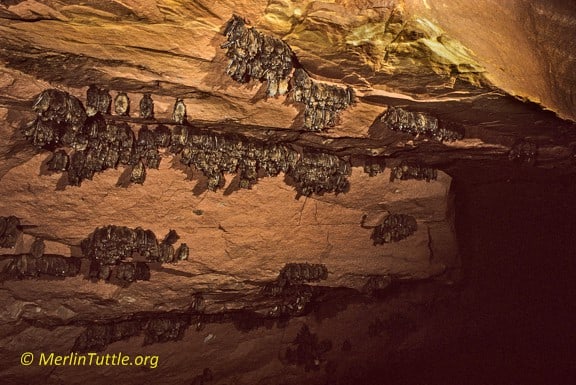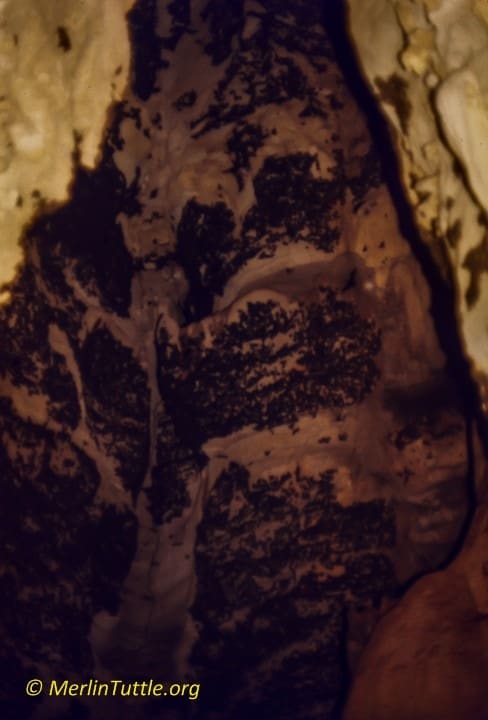The Costs of Bat Decline
Can we afford to lose bats? A recent study by Eyal Frank of the University of Chicago reveals that the dramatic decline in U.S. bat
Given the extent and rate of spread of the fungus (Pseudogymnoascus destructans), which causes WNS in North America, it is time to admit that it can’t be stopped. It is here to stay, and further attempts to document or prevent its spread are more likely to exacerbate than alleviate bat mortality. The last thing that the relatively small numbers of survivors need now is more human disturbance during a period of critical stress.
An unknown portion of the WNS die-off has almost certainly been caused by well-intended human efforts to help bats in hibernation sites. Human entry typically causes bats to raise their metabolism and burn up extra energy, even if they do not visibly arouse. A single ill-timed disturbance can force a bat to waste a month’s supply of stored fat. In bats whose energy has already been depleted by WNS this could be the straw that broke the proverbial camel’s back.
Bats are highly mobile, able to spread WNS with almost unbelievable speed, as they’ve already proven. They also know and visit thousands of roosting places unknown to us, making effective control impractical, if not impossible, even if a safe and effective cure could be found.
Suggestions of treating caves to eliminate or suppress WNS, pose risks of unintended consequences. Mycologists have warned that “Attempts to eradicate specific cave microorganisms may lead to undesired fungal or bacterial outbreaks since intact communities may interact as biological control agents.”

Federal and state agencies are currently considering a proposal to test fogging with an apparently nontoxic chemical suppressant in an abandoned railway tunnel in Georgia this winter. The tunnel’s former hibernating bat population has fallen from 5,000 to just 220 since the arrival of WNS.
Because remaining bats likely have the highest natural resistance, they may be ready to begin rebuilding on their own, as appears to have happened in other locations. Even if the proposed experiment caused half of the remainder to die needlessly, the experiment could be mistaken as successful because 110 “were saved.”

Such treatment is impractical on a large scale and would neither eliminate the fungus nor prevent reinfection of bats. It also could have unintended consequences. It could trigger costly bat arousals caused by ultrasonic sounds, odors or air movement during pressurized release. And, even if nonlethal, it could suppress non-target organisms, disrupting unique cave ecosystems of potentially great value.
At this point I believe we should pursue two primary goals to deal with WNS: 1) improve protection at key hibernation sites for all bats (not just for species already listed as endangered) and 2) expand standardized monitoring of status trends in summer habitats, based on ultrasonic detection. In some cases entry/exit counters in protected cave or mine entrances may also prove helpful. It is imperative that we accurately monitor status trends to credibly defend threatened and endangered listings and to measure the efficacy of conservation actions, including improvements in summer habitat and restoration and protection of hibernation sites.
Love our content? Support us by sharing it!
Can we afford to lose bats? A recent study by Eyal Frank of the University of Chicago reveals that the dramatic decline in U.S. bat
“Just like the old days, eh Heather?” Kent softly clicks his tally counter as he sits in his folding chair on the other side of
An important new study, recently published in Science and widely covered by major newspapers like The Guardian, The Washington Post, and The New York Times, has
Amid media announcements that the fungus that causes white-nose syndrome in bats has spread to California, and growing public concern, The Wildlife Society announced the
2024 © Merlin Tuttle’s Bat Conservation. All rights reserved.
Madelline Mathis has a degree in environmental studies from Rollins College and a passion for wildlife conservation. She is an outstanding nature photographer who has worked extensively with Merlin and other MTBC staff studying and photographing bats in Mozambique, Cuba, Costa Rica, and Texas. Following college graduation, she was employed as an environmental specialist for the Florida Department of Environmental Protection. She subsequently founded the Florida chapter of the International DarkSky Association and currently serves on the board of DarkSky Texas. She also serves on the board of Houston Wilderness and was appointed to the Austin Water Resource Community Planning Task Force.
Michael Lazari Karapetian has over twenty years of investment management experience. He has a degree in business management, is a certified NBA agent, and gained early experience as a money manager for the Bank of America where he established model portfolios for high-net-worth clients. In 2003 he founded Lazari Capital Management, Inc. and Lazari Asset Management, Inc. He is President and CIO of both and manages over a half a billion in assets. In his personal time he champions philanthropic causes. He serves on the board of Moravian College and has a strong affinity for wildlife, both funding and volunteering on behalf of endangered species.